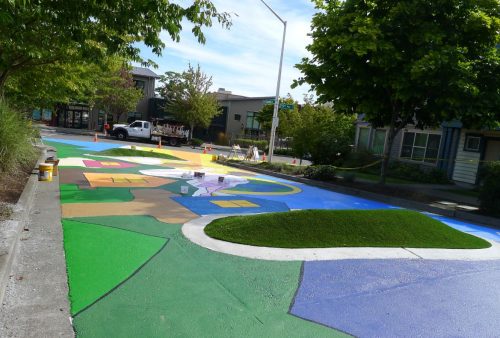Design and Siting

The following goals should inform the location and installation of all adaptive design strategies:
Safe – Every adaptive design strategy must increase or maintain an already high level of safety where installed. The primary reason for installing many such treatments is to address specific safety concerns within the right of way. Although the treatment is not permanent, it still needs to meet the minimum design and engineering requirements of the ROWIM, and applicable Federal standards such as the ADA, AASHTO, and MUTCD.
Fast – Adaptive strategies are “quick fixes” – relative to permanent treatments they should be less time consuming to design and install. To be successful, adaptive strategies should consider utilizing simple, prefabricated, or standardized materials in order to work as modules that can be “plugged” into a site with minimal effort. The process from concept to construction should be fast as well, utilizing minimal staff effort.
Low-Cost – Materials should consider simple and cost effective tools to produce an adaptive treatment that is safe, functional, contextual, and appropriate to its intended lifespan. Where aesthetics are particularly important, higher-quality and -cost materials may be necessary to provide a context-sensitive solution. Solutions should strive to minimize labor costs, and be comparatively lower than more permanent, capital improvements. Where possible, partnerships between the City and public or private organizations should be formed to make the most of existing opportunities to share resources.
Brief– Substantial progress toward a permanent solution should be achieved within 2 years and implementation should be complete within a maximum of 5 years of an adaptive design strategy. The existence of a successful adaptive strategy should demonstrate the need for a permanent solution in its place.
Experimental – With a focus on flexibility, adaptive treatments should allow designers to test new ideas and uses for the right-of-way provided that other goals are not compromised in the process. Adaptive strategies can be used as pilot or demonstration facilities prior to installation in other locations.
Public – All adaptive strategies are intended to address the need for increased public space or public safety. They should be available to the general public at all times regardless of age or ability and be located in areas that are compliant with ADA standards.
Community Driven – Local communities should be encouraged to initiate and champion adaptive design strategies that address their needs. In cases where new public space is created, community partners can act as stewards by initiating, maintaining, and, programming the neighborhood space.
Equity – Adaptive strategies and the resources needed for their implementation should be distributed evenly throughout the city. The locations most in need of fast solutions are often those that receive the least attention from private investment – and those neighborhoods can also benefit most from an innovative rethinking of road uses.
